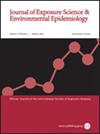Heat stress-induced heat shock protein 70 (HSP70) expressions among vulnerable populations in urban and rural areas Klang Valley, Malaysia
IF 4.7
3区 医学
Q2 ENVIRONMENTAL SCIENCES
Journal of Exposure Science and Environmental Epidemiology
Pub Date : 2025-03-04
DOI:10.1038/s41370-025-00764-4
引用次数: 0
Abstract
As climate change raises global temperatures, there remains a notable gap in understanding the body’s mechanisms of heat stress defense exhibited by Heat Shock Protein (HSP) within the populations. This study aims to investigate the expression level of HSP70 in response to indoor heat exposure among vulnerable populations in both urban and rural settings. A comparative cross-sectional was conducted among 108 participants from urban and rural areas in Klang Valley, Malaysia. The study included face-to-face interviews, indoor heat exposure monitoring, and thermal stress classification using the Universal Thermal Climate Index (UTCI). HSP70 gene and protein expressions were analyzed using reverse-transcription quantitative polymerase chain reaction (RT-qPCR) and HSP70 High Sensitivity Enzyme-linked Immunosorbent Assay (ELISA), respectively. Urban areas experienced signficantly higher UTCI heat exposure levels than rural areas (p < 0.001). In response to heat stress, vulnerable populations in urban areas exhibited higher HSP70 gene relative expression and HSP70 protein expression. A significant mean difference in the plasma HSP70 protein expression was observed between the two groups (p < 0.001). The linear mixed model (LMM) revealed a significant association between UTCI heat exposure levels and HSP70 gene and protein expression in both groups (p < 0.001).

热应激诱导热休克蛋白70 (HSP70)在马来西亚巴生谷城乡弱势人群中的表达
背景:随着气候变化导致全球气温升高,人们对人体热休克蛋白(HSP)在人群中表现出的热应激防御机制的理解仍然存在明显的空白。目的:本研究旨在探讨HSP70在城市和农村脆弱人群中对室内热暴露的表达水平。方法:对来自马来西亚巴生谷城市和农村地区的108名参与者进行比较横断面研究。该研究包括面对面访谈、室内热暴露监测和使用通用热气候指数(UTCI)进行热应力分类。分别采用逆转录定量聚合酶链反应(RT-qPCR)和HSP70高灵敏度酶联免疫吸附试验(ELISA)分析HSP70基因和蛋白的表达。结果:城市地区的UTCI热暴露水平明显高于农村地区(p影响:虽然以前的研究已经在受控的实验环境中检查了健康个体对热应激的细胞反应,但我们的研究独特地关注了实际环境条件下的脆弱个体。这对于建立这些种群适应气候变化和周围温度能力的基线信息至关重要。这些信息对于建设有复原力的社区和预防极端高温事件期间中暑等致命事件至关重要。通过强调城市和农村人口之间的差异,本研究为决策者和卫生从业人员设计特定地点和特定人群的热应激缓解策略提供了重要信息。
本文章由计算机程序翻译,如有差异,请以英文原文为准。
求助全文
约1分钟内获得全文
求助全文
来源期刊
CiteScore
8.90
自引率
6.70%
发文量
93
审稿时长
3 months
期刊介绍:
Journal of Exposure Science and Environmental Epidemiology (JESEE) aims to be the premier and authoritative source of information on advances in exposure science for professionals in a wide range of environmental and public health disciplines.
JESEE publishes original peer-reviewed research presenting significant advances in exposure science and exposure analysis, including development and application of the latest technologies for measuring exposures, and innovative computational approaches for translating novel data streams to characterize and predict exposures. The types of papers published in the research section of JESEE are original research articles, translation studies, and correspondence. Reported results should further understanding of the relationship between environmental exposure and human health, describe evaluated novel exposure science tools, or demonstrate potential of exposure science to enable decisions and actions that promote and protect human health.

 求助内容:
求助内容: 应助结果提醒方式:
应助结果提醒方式:


